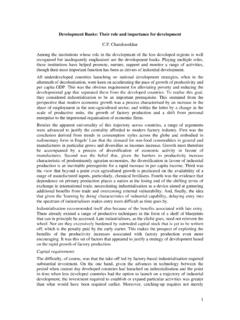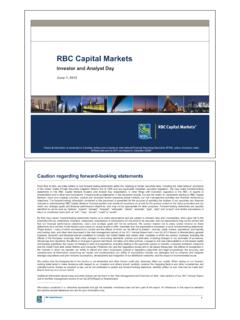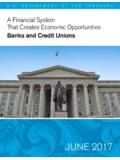Transcription of Himalaya Labs - Executive Summary
1 Himalaya Labs - Executive Summary Decentralised Global Capital Markets Platform (DGCAMP)Author Arifa Khan, Founder, Himalaya Labs - 7 July 2017 Companies and investors lose out when businesses float on the stock market because banks and other advisers are charging extra ordinary fees, the Organisation for Economic Co-operation and Development has warned. High levels of fees (7-10%) and parallel pricing akin to tacit collusion appear to have increased. This increases the cost of equity and works against long-term productive investment. Reinforcing competitive conditions in these markets could contribute to better outcomes for globalisation - The Telegraph 30 May 2017 White Paper is coming soon!
2 DECENTRALISED CAPITAL MARKETS PLATFORM COPYRIGHT 2017 Himalaya LABS 1 Introduction Global capital market flows are a complex phenomenon driven by multitudinous factors. They are characterised by several anomalies that contradict the neoclassical theory of economics. This paper notes the gross inefficiencies in the current state of markets and the presence of a huge swathe of intermediaries, and proposes a decentralised two-sided marketplace platform as a solution. While it is beyond the scope of this paper to comprehensively represent and depict all the forces and factors that influence the markets, it demonstrates that there are inefficiencies, using a few simplistic models that perhaps oversimplify the functioning of the complex markets.
3 The solution proposed will eventually extract embedded value from intermediaries, by eliminating some if not all information asymmetries, and redistribute the value to the issuers and investors. The theory of Revenue Equivalence in Buyer-Seller Markets posits that there are market clearing prices for every state of the market, with and without intermediaries, and revenues remain the same for the seller at market equilibrium in every type of a sale including multi-party auctions of different kinds (single buyer or multi-buyer auctions and for different types of auctions like Dutch or Vickrey).
4 (Mathematical Proof is presented in our White Paper). Extending the above Revenue Equivalence theory to the complicated capital markets in general, it can be deduced that in a market without intermediaries, the surplus enjoyed by erstwhile intermediaries will simply be transferred to the buyers and sellers. The benefits of the proposed solution are mainly: Disintermediation of investment banks (saving on advisory fees that would be paid to investment banks for manual processes that a smart contract platform can deliver much more efficiently) A global trustless platform for investors and capital seekers to transact directly One of the biggest real world applications for legitimising the crypto economy and blockchain technology Decentralisation of innovation DECENTRALISED CAPITAL MARKETS PLATFORM COPYRIGHT 2017 Himalaya LABS 2 Foundational infrastructure to a potential App Market Place where asset managers and other intermediaries can build applications on top of our core protocol Foundational to disruption of concomitant industries such as Asset Management.
5 Brokerages etc Access to capital has always been one of the key determinants of corporate survival and growth. Yet, pathways to big investments have historically been systems of privilege. Being located in Silicon Valley, belonging to elite universities, incubators, investor networks and clubs, and being advised by a reputed investment bank - all constitute barriers that hinder democratic access to capital for deserving innovators located away from Superhubs. Being systems of privilege, Investment Banks have long thrived on these market imperfections to earn abnormal fees.
6 Source: FT League Tables Companies and investors lose out when businesses float on the stock market because banks and other advisers are charging extra ordinary fees, the Organisation for Economic Co-operation and Development has warned. High levels of fees (7-10%) and parallel pricing akin to tacit collusion appear to have increased. This increases the cost of equity and works against long-term productive investment. Reinforcing competitive conditions in these markets could contribute to better outcomes for globalisation - The Telegraph 30 may 2017 DECENTRALISED CAPITAL MARKETS PLATFORM COPYRIGHT 2017 Himalaya LABS 3 Inefficiency in Global Capital Markets: Neoclassical models predict that countries that enjoy higher productivity growth should enjoy new net capital inflows.
7 However, empirical evidence points to the contrary, in what is termed as the Allocation Puzzle by many researchers. The biggest assumption underlying the theory - one of perfect capital mobility, fails to hold in reality. Some factors that plausibly contribute to the discrepancies in predicted vs actual global capital flows include but are not limited to: Heterogeneous degrees of financial development between developed and developing countries Differential rates of growth of economies, driven by macroeconomic factors Differential savings rates due to population trends, demographics, purchasing power, cultural and behavioral savings patterns Idiosyncratic risks of varying degrees Financial frictions in incomplete markets Systemic constraints such as availability of credit and borrowing constraints Information asymmetries (vis-a-vis perfect markets assumed in theory)
8 Different taxation regimes (rates of return on financial capital are kept artificially low in some countries by means of corporate taxation and dividend taxation) Global Two-Way Capital Flows: Research points to distinctive demand-supply dynamics for Financial Capital (Savings) vis-a-vis Fixed Capital (Capital Investment in Firms). An empirically observed phenomenon is Financial Capital flowing from savings-rich emerging economies to developed economies, and Fixed capital flowing in the opposite direction to emerging economies where marginal product of capital is high due to capital scarcity.
9 (Supporting literature review in Annexure 1.) Indeed, the asset management industry is well-developed and sophisticated wherein financial capital flows freely and frictionlessly, as evidenced by frequent global capital flights in response to stock market shocks. However, capital markets of emerging economies are still not sophisticated enough, or integrated adequately with the global markets and therefore suffer from inefficiencies such as scarcity of capital, lack of access to DECENTRALISED CAPITAL MARKETS PLATFORM COPYRIGHT 2017 Himalaya LABS 4investors, added costs of hedging foreign currency borrowings etc despite their high growth.
10 Foreign Exchange is a crucial barrier in international capital mobility as countries have elaborate foreign exchange management rules to safeguard economies from excessive shocks, as financial liberalisation is not uniform. Country regulations introduce more inefficiencies. Some countries like India, for example, have ceilings imposed by Reserve Bank of India on foreign direct investments in each industry, and caps on cost of borrowing vis-a-vis the horizon. Agency problems: Commercial Banks in emerging countries that hold household savings often fail to perform their fiduciary duty, and lend to favoured clients who then go on to default wilfully, resulting in huge non-performing assets on banks balance sheets which indirectly are borne by the tax payers /savers.






